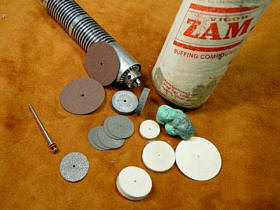Slabbing, Shaping, Polishing Turquoise Cabs Using Foredom Handpiece
This paper will describe the process of slabbing, shaping and polishing turquoise cabs using Foredom Handpiece and various grinding discs. Other stone materials require different polishing methods and will not be covered in this paper.
3 Minute Read
This paper will describe the process of slabbing, shaping and polishing turquoise cabs using Foredom Handpiece and various grinding discs. Other stone materials require different polishing methods and will not be covered in this paper.
You assume all responsibility and risk for the use of the safety resources available on or through this web page. The International Gem Society LLC does not assume any liability for the materials, information and opinions provided on, or available through, this web page. No advice or information provided by this website shall create any warranty. Reliance on such advice, information or the content of this web page is solely at your own risk, including without limitation any safety guidelines, resources or precautions, or any other information related to safety that may be available on or through this web page. The International Gem Society LLC disclaims any liability for injury, death or damages resulting from the use thereof.
The All-In-One Jewelry Making Solution At Your Fingertips
When you join the Ganoksin community, you get the tools you need to take your work to the next level.
Trusted Jewelry Making Information & Techniques
Sign up to receive the latest articles, techniques, and inspirations with our free newsletter.
